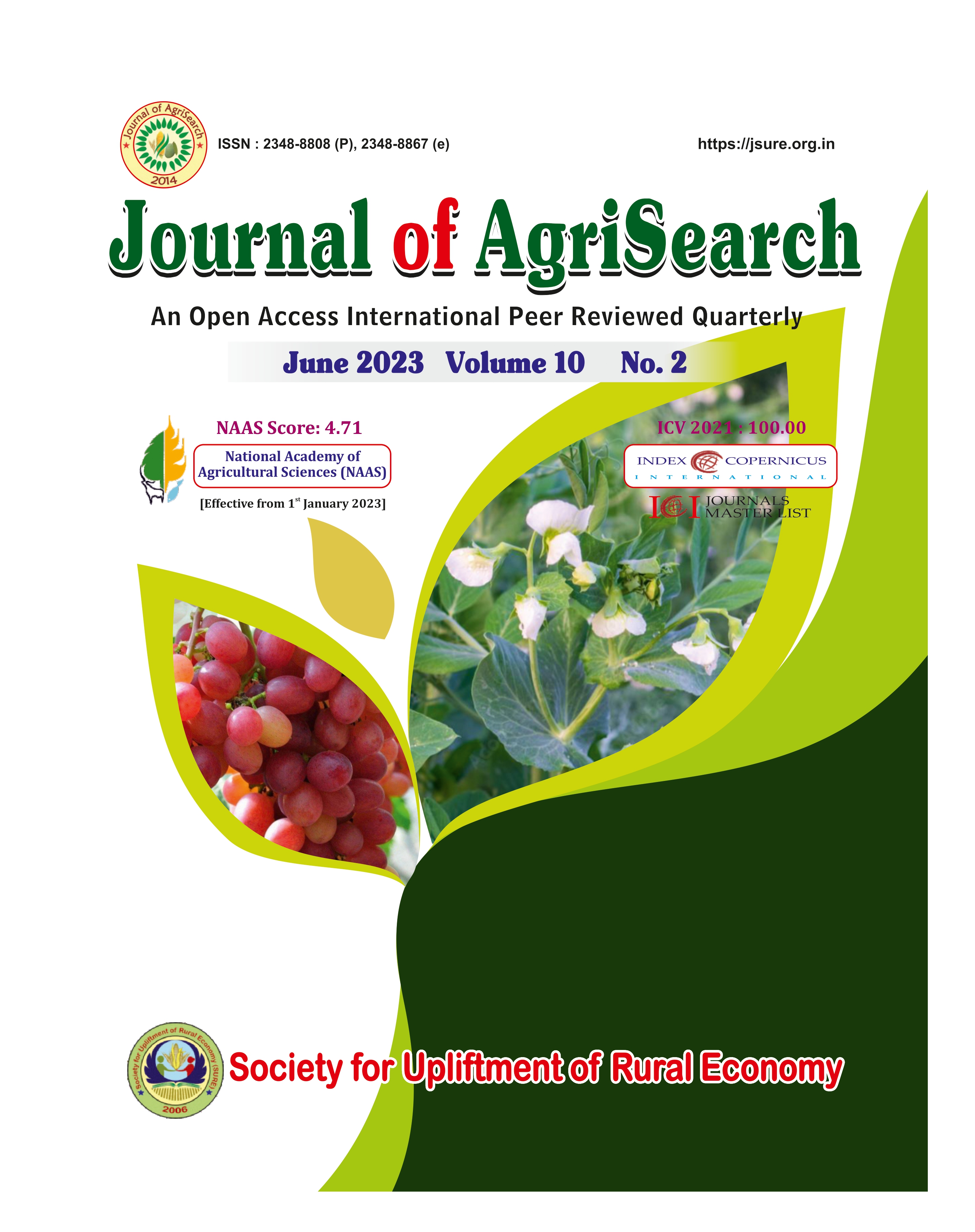Gamma Test-based MLP based ANN Model for Groundwater Fluctuation Forecasting in Kanpur District, Uttar Pradesh
Groundwater Fluctuation Forecasting using Gamma Test-based MLP based ANN Model
DOI:
https://doi.org/10.21921/jas.v10i02.12720Keywords:
Neural networks, Forecasting, Gamma test, Groundwater level fluctuationsAbstract
This study seeks to determine the accuracy of the groundwater level fluctuations forecasted at the Kanpur district of India using artificial neural networks (ANNs). An overview of how gamma tests can be useful together to decrease the huge amount of work involved in the process of trial-and-error in nonlinear modeling method is presented in this study. The results indicated that performance of multilayer perceptron (MLP) based neural network (M-16, architecture 4-18-1) is satisfactory in the groundwater level fluctuations forecasting. The performance assessment shows that the MLP model performs significantly better. In future studies, it might be useful to apply these approaches as a laborious approach for ensuring that the appropriate results are obtained very quickly even though they are time-consuming.
References
Arora B, Mohanty BP, McGuire JT.2012. Uncertainty in dual permeability model parameters for structured soils. Water Resour. Res. 48:. https://doi.org/10.1029/2011WR010500
Arora B, Mohanty BP, McGuire JT.2011. Inverse estimation of parameters for multidomain flow models in soil columns with different macropore densities. Water Resour Res 47:. https://doi.org/10.1029/2010WR009451
Bajirao TS, Kumar P, Kumar M, et al .2021. Potential of hybrid wavelet-coupled data-driven-based algorithms for daily runoff prediction in complex river basins. Theor. Appl. Climatol. 145:1207–1231. https://doi.org/10.1007/s00704-021-03681-2
Ch S and Mathur S.2012. Groundwater level forecasting using SVM-PSO. Int. J. Hydrol. Sci. Technol. 2:202. https://doi.org/10.1504/IJHST.2012.047432
Choubin B and Malekian A.2017. Combined gamma and M-test-based ANN and ARIMA models for groundwater fluctuation forecasting in semiarid regions. Environ. Earth Sci. 76:538. https://doi.org/10.1007/s12665-017-6870-8
Coulibaly P, Anctil F, Aravena R, Bobée B.2001. Artificial neural network modeling of water table depth fluctuations. Water Resour Res. 37:885–896. https://doi.org/10.1029/2000WR900368
Gholami V, Khaleghi MR, Pirasteh S, Booij MJ.2021. Comparison of self-organizing map, artificial neural network, and co-active neuro-fuzzy inference system methods in simulating groundwater quality: Geospatial Artificial Intelligence. Water Resour. Manag. https://doi.org/10.1007/s11269-021-02969-2
Guzman SM, Paz JO, Tagert MLM.2017. The Use of NARX Neural Networks to Forecast Daily Groundwater Levels. Water Resour. Manag. 31:1591–1603. https://doi.org/10.1007/s11269-017-1598-5
Jajarmizadeh M, Kakaei Lafdani E, Harun S, Ahmadi A.2015. Application of SVM and SWAT models for monthly streamflow prediction, a case study in South of Iran. KSCE J Civ. Eng. 19:345–357. https://doi.org/10.1007/s12205-014-0060-y
Kumar A, Singh VK, Saran B, et al.2022. Development of Novel Hybrid Models for Prediction of Drought- and Stress-Tolerance Indices in Teosinte Introgressed Maize Lines Using Artificial Intelligence Techniques. Sustainability 14:2287. https://doi.org/10.3390/su14042287
Langevin CD, Hughes JD, Banta ER, et al.2017. Documentation for the MODFLOW 6 groundwater flow model. US Geological Survey
Malik A, Kumar A, Kisi O.2018. Daily pan evaporation estimation using heuristic methods with gamma test. J. Irrig. Drain. Eng. 144:. https://doi.org/10.1061/(ASCE)IR.1943-4774.0001336
Mirzania E, Vishwakarma DK, Bui Q-AT, et al.2023. A novel hybrid AIG-SVR model for estimating daily reference evapotranspiration. Arab J. Geosci. 16:301. https://doi.org/10.1007/s12517-023-11387-0
Nayak PC, Rao YRS, Sudheer KP.2006. Groundwater Level Forecasting in a Shallow Aquifer Using Artificial Neural Network Approach. Water Resour. Manag. 20:77–90. https://doi.org/10.1007/s11269-006-4007-z
Rashidi S, Vafakhah M, Lafdani EK, Javadi MR.2016. Evaluating the support vector machine for suspended sediment load forecasting based on gamma test. Arab J Geosci 9:583. https://doi.org/10.1007/s12517-016-2601-9
Sahoo S, Russo TA, Elliott J, Foster I (2017) Machine learning algorithms for modeling groundwater level changes in agricultural regions of the U.S. Water Resour. Res. 53:3878–3895. https://doi.org/10.1002/2016WR019933
Sahu RK, Müller J, Park J, et al.2020. Impact of Input Feature Selection on Groundwater Level Prediction From a Multi-Layer Perceptron Neural Network. Front Water 2:. https://doi.org/10.3389/frwa.2020.573034
Sarangi A and Bhattacharya AK.2005. Comparison of Artificial Neural Network and regression models for sediment loss prediction from Banha watershed in India. Agric. Water Manag. 78:195–208. https://doi.org/10.1016/j.agwat.2005.02.001
Saroughi M, Mirzania E, Vishwakarma DK, et al.2023. A Novel Hybrid Algorithms for Groundwater Level Prediction. Iran J Sci Technol Trans Civ Eng. https://doi.org/10.1007/s40996-023-01068-z
Shukla R, Kumar P, Vishwakarma DK, et al.2021. Modeling of stage-discharge using back propagation ANN-, ANFIS-, and WANN-based computing techniques. Theor. Appl. Climatol. https://doi.org/10.1007/s00704-021-03863-y
Singh AK, Kumar P, Ali R, et al.2022. An Integrated Statistical-Machine Learning Approach for Runoff Prediction. Sustainability 14:8209. https://doi.org/10.3390/su14138209
Singh VK, Kumar D, Kashyap PS, Kisi O.2018. Simulation of suspended sediment based on gamma test, heuristic, and regression-based techniques. Environ. Earth Sci. 77:708. https://doi.org/10.1007/s12665-018-7892-6
Singh VK, Kumar D, Kashyap PS, Singh PK.2019. Predicting Unsaturated Hydraulic Conductivity of Soil Based on Machine Learning Algorithms. In: Conference: Proceedings of International Conference Opportunities and Challenges in Engineering, Management and Science (OCEMS-2019)At: Bareilly, India
Singh VK, Kumar P, Singh BP.2016. Rainfall-runoff modeling using artificial neural networks (ANNs) and multiple linear regression (MLR) techniques. Indian J. Ecol. 43:436–442
Solgi R, Loáiciga HA, Kram M (2021) Long short-term memory neural network (LSTM-NN) for aquifer level time series forecasting using in-situ piezometric observations. J. Hydrol. 601:126800. https://doi.org/10.1016/j.jhydrol.2021.126800
Steefel CI, Appelo CAJ, Arora B, et al.2015. Reactive transport codes for subsurface environmental simulation. Comput. Geosci. 19:445–478. https://doi.org/10.1007/s10596-014-9443-x
Vishwakarma DK, Kumar R, Kumar A, et al.2022. Evaluation and development of empirical models for wetted soil fronts under drip irrigation in high-density apple crop from a point source. Irrig. Sci. https://doi.org/10.1007/s00271-022-00826-7
Vishwakarma DK, Kuriqi A, Abed SA, et al.2023. Forecasting of stage-discharge in a non-perennial river using machine learning with gamma test. Heliyon 9:e16290. https://doi.org/10.1016/j.heliyon.2023.e16290.


